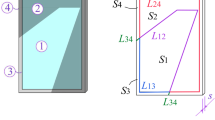Abstract
The paper presents a method for a quantitative study of the influence of the diurnal air temperature cycle, the incidence of solar energy on exposed surfaces and transmission through glass areas, the longwave radiation exchange with the surroundings, and the energy exchange resulting from natural ventilation. The thermal response of a room in a typical concrete office building with glass areas facing south in the northern hemisphere is treated in detail by means of a digital computer program sufficiently general to handle a large variety of problems. For the first time the influence of “programmed” natural ventilation can be determined in advance. The design of optimal thermal enclosures can be achieved through the technique of “exhaustive analysis” using methods described in this paper.
Zusammenfassung
Es wird über eine Methode für die quantitative Untersuchung der Einflüsse des tÄglichen Gangs der Lufttemperatur, der Sonnenenergieaufnahme an den bestrahlten OberflÄchen und durch die Glasfenster, des langwelligen Strahlungsaustausches mit der Umgebung und des Energieaustausches durch die natürliche Ventilation berichtet. Das thermische Verhalten eines Raumes in einem typischen Beton-Bürohaus mit südlich orientierten GlasfensterflÄchen auf der nördlichen Halbkugel ist ausführlich durch das “digital” Rechenmaschinenprogramm untersucht worden, das genügt, um eine ausführliche Anzahl verschiedener Probleme zu behandeln. Zum erstenmal kann der Einfluss der programmierten natürlichen Ventilation vorausbestimmt werden. Der Entwurf eines thermisch optimalen eingeschlossenen Raumes kann durch die hier beschriebenen “erschöpfenden Analysen” gegeben werden.
Resume
Ce mémoire présente une méthode qui permet d'étudier quantitativement l'influence des facteurs suivants: Le cycle diurne de la température de l'air, l'angle d'incidence de l'énergie solaire sur les parois qui y sont exposées, la transmission de la chaleur à travers des surfaces de verre, les échanges d'énergie avec le milieu ambiant par rayonnement calorifique sur ondes longues et, enfin, les échanges d'énergie par ventilation naturelle. On étudie en détail les conditions thermiques d'une chambre située dans un bâtiment de béton pourvu de parois de verre exposées au sud, le tout étant situé à une latitude boréale. Cette étude est effectuée au moyen d'un programme d'ordinateur digital suffisament général pour s'appliquer à la solution de nombreux problèmes de transmission de chaleur. On montre, pour la première fois, que l'on peut déterminer d'avance l'influence d'une ventilation naturelle “programmée”. L'établissement de l'optimum thermique des intérieurs peut se faire par une analyse très poussée, c'est à dire à l'aide des méthodes décrites dans cette étude.
Similar content being viewed by others
References
BUCHBERG, H. (1955): Electric analogue prediction of the thermal behavior of an inhabitable enclosure. Trans. Am. Soc. Heat. Air-cond. Eng., 61: 339–386.
DRAKE, W.B., BUCHBERG, H. and LEBELL, D. (1959): Transfer admittance functions for typical composite wall sections. Trans. Am. Soc. Heat. Aircond. Eng., 65: 523–540.
EUSER, P. (1961): The application of analogues in the solution of heat transfer problems. II. Recent heat methods in the physics of Buildings. (In Dutch), Ingenieur ('s-Gravenhage), 73: 0 63 - 0 74.
PARMELEE, G.V., VANCE, P. and CERNY (1957): Analysis of an air conditioning thermal circuit by an electronic differential analyzer. Trans. Am. Soc. Heat Air-cond. Eng., 63: 129–143.
TAYLOR, E.D., BERGER, B. and BLAYCLOCK, G. (1961): Measured and electrical-model characteristics of buildings heated by floor thermal storage. Proc. Inst. Elect. Eng., 108A: 226–238.
Author information
Authors and Affiliations
Rights and permissions
About this article
Cite this article
Buchberg, H., Bussell, B. & Reisman, R. On the determination of optimal thermal enclosures. Int J Biometeorol 8, 103–111 (1964). https://doi.org/10.1007/BF02187574
Issue Date:
DOI: https://doi.org/10.1007/BF02187574




